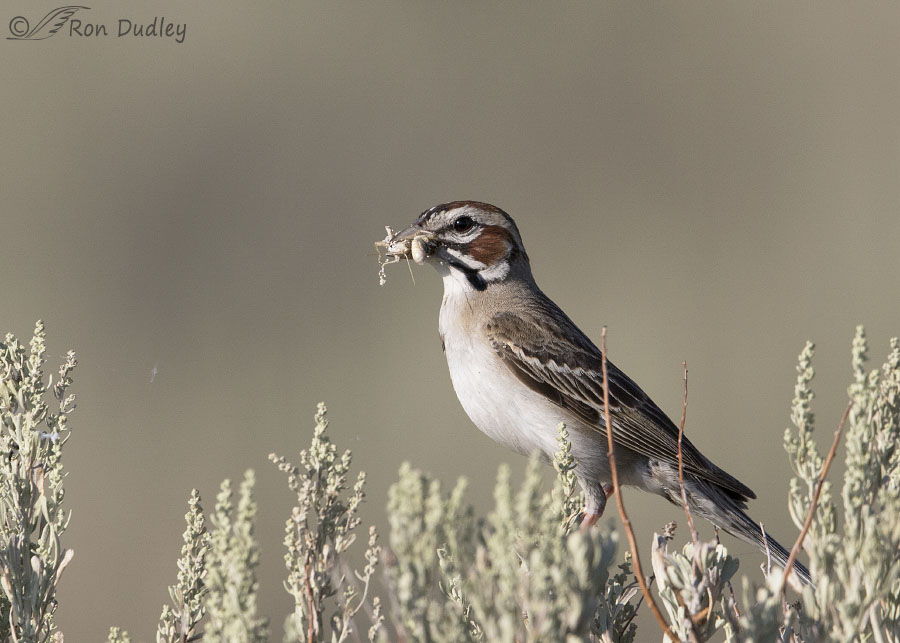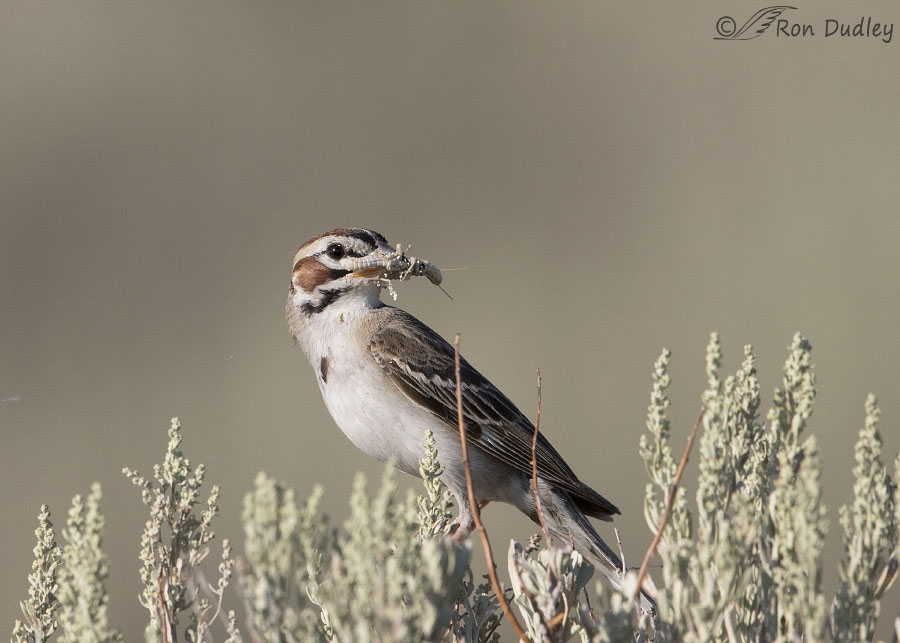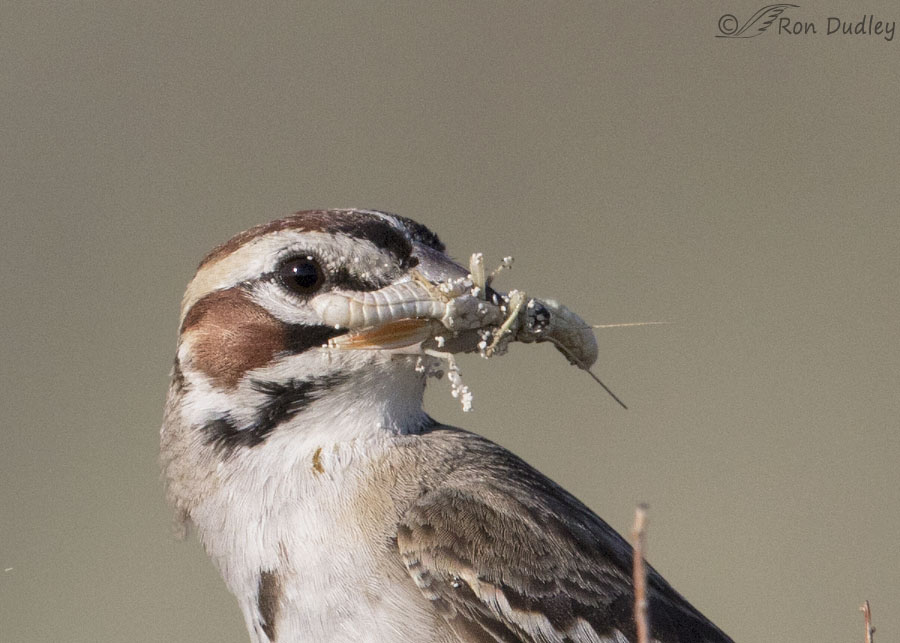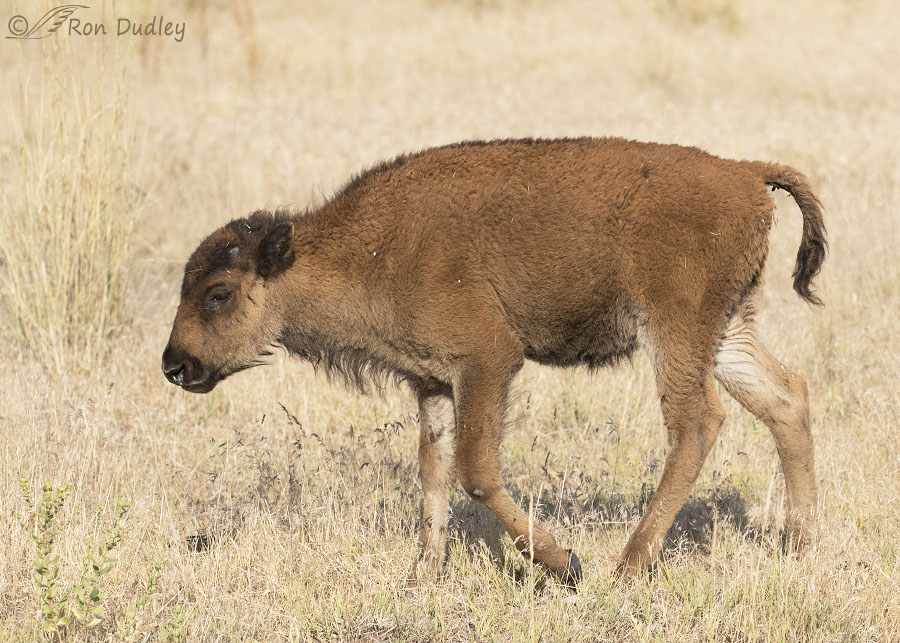A few (very few) of the birds on Antelope Island were still in the late stages of nesting yesterday, including this Lark Sparrow and a female Bullock’s Oriole I saw at a distance feeding a recent fledgling.

1/3200, f/6.3, ISO 500, Canon 7D Mark II, Canon EF 500mm f/4L IS II USM + EF 1.4 III Extender, not baited, set up or called in
The Lark Sparrow wasn’t particularly close but it had insects in its bill (presumably for fledglings it was still feeding) which always adds some interest for me. I didn’t have much time with it because a pickup was approaching me from behind so I had to move on.

1/3200, f/6.3, ISO 500, Canon 7D Mark II, Canon EF 500mm f/4L IS II USM + EF 1.4 III Extender, not baited, set up or called in
This is the only other pose I was able to get.
I always wonder what the prey is. I thought this looked like a couple of grasshoppers and a…

huge crop of the previous image (5% of the original) seemed to confirm that at least one of them was. I’m not sure about the insect on the right and the grasshopper on the left was a paler color than any grasshoppers I remember seeing.
Birds on the island were extremely slow. It’s just too damned hot out there. I suspect many of them have moved on to higher elevations where it’s cooler. If I hadn’t found this Lark Sparrow I’d have been essentially bird-skunked yesterday morning.

About the only other subjects of interest I saw was a large herd of bison moving down off the mountain for a cool drink at the guzzler that park personnel have provided them for water. This young calf was following dutifully behind its mother, almost as if it were in a trance. I took 43 photos as it walked by close to me and I was disappointed to not get a catch light in a single one. I think it was very nearly walking in its sleep.
At this age they’re still called “Reds” although they’re not as red as they were a few weeks ago.
Though I was pleased to get the Lark Sparrow with prey I don’t think I’ll be going back to the island anytime soon. The summer doldrums have arrived.
Ron


Ron, I “googled” the lark sparrow and saw that it has a black spot in the center of the chest. You captured that spot. It also said that there is a stripe over the eye. The bird has beautiful coloration.
I never knew that young bison are called “Reds” for a good reason.
Thank you Ron.
They have some extremely interesting mating rituals too, Alice. Thanks.
Intriguing to learn that grasshopper colouration changes with the amount of rain. I suspect it is an excellent camoflague ploy too. Love both the sparrow and the red. And loathe the heat. If I could sleep walk through summer I would.
I never thought about it relating to camouflage. Thanks for mentioning it – I’ll bet you are right!
Interesting thought about camouflage, EC. The drier it is the paler the vegetation is for longer, at least around here.
Here too. And after the vegetation has crispified it goes to dust.
Everyone slows down when it is hot! Wildlife and humans! The only saving grace when I’m out photographing and its hot is the AC in my truck!
Your images are great of both the calf and Lark Sparrow. Wish I could help you with the insect, I have trouble enough remembering eastern stuff let alone even trying for western critters. I have to admit the Lark Sparrow is one hell of a beautiful sparrow and doesn’t even look disheveled by the heat.
I always marvel at birds’ ability to pick up multiple insects without dropping them a la Aesop and the dog. I’ll echo Everett — I’ll bet Dr. Tallamy’s lab would love to take a gander at those shots.
The red is adorable (although I’d really like to give this little fella a bath). I think the sense of somnambulism is heightened because there’s no catchlight.
Ha, if you saw these guys roll around in the dirt the way they do you’d think ‘he’ was pretty clean, Marty.
Reds are always fun to see. I like the Lark Sparrow shots. I have no clue about the inset you can’t identify, but I can tell you that many grasshoppers differ in color depending on how much rain happens during a given year. A good example of that is the plains lubber grasshopper that can range from browns to pastels to autumn colors. The brighter colors occur in rainy years.
I didn’t know that about grasshoppers, Susan. Thanks for that info.
Beautiful photos. We have them nearby. I wish they would eat the Grasshoppers who love to chomp on my flowers..The baby Bison is adorable. Walking in it’s sleep lol.
“Walking in it’s sleep”
That’s what it looked like, Jean. It actually stumbled once.
Hi Ron, I so enjoy your photos and commentary! A note about your injury…one needs to be careful for infection on digits because the cell structure is different than other places on the body and sometimes infections instead of coming to a head near the surface, go inward causing dangerous infections sometimes to the bones. I had one on a thumb as a child. The doctor said it was called a felon…caused by Staphylococcus aureus. I was sent to the OR where they immediatly cut off the tip of my thumb! Best wishes for smooth healing!
Thanks for the heads up, Mary.
Lark Sparrows are such handsome birds…as this one proves….Didn’t know bison babies were called “reds”…I hope this one was OK…(you, too!)…
Agreed, Patty. I think they’re among the best looking sparrows.
Wonderful series Ron!
Charlotte
Thanks, Charlotte.
Beautiful photos despite the summer doldrums. Especially like the pics of the lark sparrow but I also enjoyed looking at the sleepy little calf. I hope to add the lark sparrow to my “sparrow” list of sightings one day!
Thank you, Joanne.
Great photos Ron. That Lark sure has a mouthful. Like the closeup. A good shot to send to those folks back east that are studying what insects birds eat. The calf does appear to be almost sleepwalking. Have a good weekend – rest that finger.
Everett Sanborn, Prescott AZ
Thanks, Everett. Yes, I should send them the photos.
Obviously there are plenty of “bugs” around for feed! Buffalo calf is pretty tho, as you mentioned, it appears to be on auto-pilot – suppose the heat is an issue for them?
Buffalo calf is pretty tho, as you mentioned, it appears to be on auto-pilot – suppose the heat is an issue for them?
Oh, the heat certainly is, Judy. Sometimes it looks like they’re really suffering from it.
Agreed…sometimes while driving through an area, I wondered if everything has gone on vacation. The Lark Sparrow was a good find with the oddly colored larva. While out west a few years ago I was lucky to get some photos of a herd of bison (contained behind fencing of course). The invisible umbilical cord kept the youngster close by for sure. They are magnificent creatures.
They don’t go far from mama. They’ll frolic with other calves for a short period but they never stray very far.